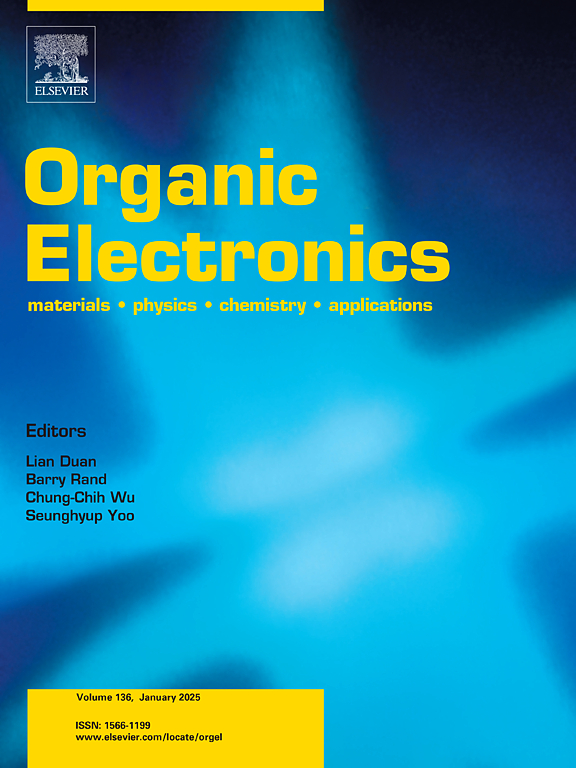窄频带深蓝发射的n-杂环翼硼氮多谐振发射器的模块化方法
IF 2.6
4区 工程技术
Q3 MATERIALS SCIENCE, MULTIDISCIPLINARY
引用次数: 0
摘要
硼氮多共振热激活延迟荧光(BN MR-TADF)发射器由于其窄带发射和高效率而引起了高性能有机发光二极管(oled)的广泛关注。然而,含有缺电子n杂环的发射体很少被报道,并且由于在苛刻的硼化条件下的合成挑战,在很大程度上仍未被探索。我们提出了一种保护/去保护策略,使用苯基来克服这一限制,提供可修改的核心分子HBN,使后期模块化引入缺电子的n-杂环,以提供各种新型n-杂环带翼BN发射器,HetBN系列。应该指出的是,一个独特的顺序两步脱苄基协议被开发,必须应用于去除两个苄基。如本文所示,成功制备了常规方法无法获得的四种发射体oPyBN、mPyBN、PymBN和PhTzBN。它们发出波长在454nm以下可微调的深蓝色光致发光,plqy在90%以上,fwhm在30nm以下窄,激子动力学快,证明了n -杂环在微调BN MR-TADF发射体的光物理性质方面的有益作用。用PhTzBN制备的OLED器件在444 nm处显示出深蓝色发射,窄频宽为31 nm (0.19 eV),国际委员会Éclairage (CIE)坐标为(0.16,0.08),最大外量子效率(EQE)为5.2%。本研究为新型n -杂环带翼BN MR-TADF发射器的模块化合成铺平了道路。本文章由计算机程序翻译,如有差异,请以英文原文为准。

A modular access to N-heterocycle-winged boron-nitrogen multiresonant emitters with narrowband deep-blue emissions
Boron-nitrogen multiresonant thermally activated delayed fluorescence (BN MR-TADF) emitters have attracted widespread attention for high performance organic light-emitting diodes (OLEDs) due to their narrowband emissions and high efficiencies. However, emitters incorporating electron-deficient N-heterocycles are rarely reported and remain largely unexplored because of synthetic challenges under harsh borylation conditions. We present a protection/deprotection strategy using benzyl groups to overcome this restriction to offer a modifiable core molecule HBN, enabling late-stage modular introduction of electron-deficient N-heterocycles to furnish a variety of novel N-heterocycle-winged BN emitters, the HetBN series. It should be noted that a unique sequential two-step debenzylation protocol is developed and must be applied to remove both benzyl groups. As exemplified herein, four emitters, oPyBN, mPyBN, PymBN, and PhTzBN, which are inaccessible via conventional methods, were successfully prepared. They emit deep-blue photoluminescence with fine-tuneable wavelengths below 454 nm, high PLQYs above 90 %, narrow FWHMs under 30 nm, and fast exciton dynamics, demonstrating the beneficial effect of N-heterocycles in fine-tuning the photophysical properties of BN MR-TADF emitters. A preliminary OLED device fabricated with PhTzBN exhibited deep-blue emission at 444 nm with a narrow FWHM of 31 nm (0.19 eV), the Commission Internationale de l’Éclairage (CIE) coordinates of (0.16, 0.08), and a maximum external quantum efficiency (EQE) of 5.2 %. This study paves the way to modular synthesis of innovative N-heterocycle-winged BN MR-TADF emitters.
求助全文
通过发布文献求助,成功后即可免费获取论文全文。
去求助
来源期刊

Organic Electronics
工程技术-材料科学:综合
CiteScore
6.60
自引率
6.20%
发文量
238
审稿时长
44 days
期刊介绍:
Organic Electronics is a journal whose primary interdisciplinary focus is on materials and phenomena related to organic devices such as light emitting diodes, thin film transistors, photovoltaic cells, sensors, memories, etc.
Papers suitable for publication in this journal cover such topics as photoconductive and electronic properties of organic materials, thin film structures and characterization in the context of organic devices, charge and exciton transport, organic electronic and optoelectronic devices.
 求助内容:
求助内容: 应助结果提醒方式:
应助结果提醒方式:


